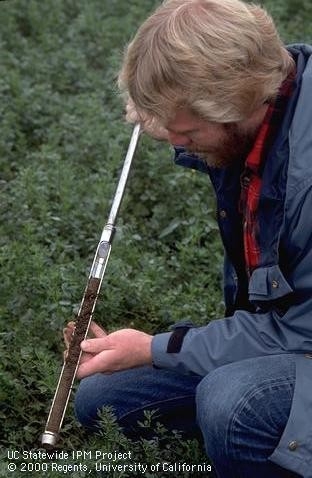
A high-analysis phosphorus fertilizer, such as 11-52-0, or liquid 10-34-0 is usually the most economical source of phosphorus, and both of these sources will result in the same yield response per pound of P2O5 applied. I cautioned that if choosing a fertilizer that also contains some nitrogen, like these do, he would need to pay attention to weed control because the added nitrogen could stimulate weed growth.
This grower expects to produce around 10 tons/acre/year of alfalfa in that field. Given that yield expectation, the crop will remove 52 pounds of phosphorus each year (119 pounds of P2O5). Since this is a two-year old field and the grower would like to keep it in for two more years, he will need to provide approximately 240 lb/A of P2O5. Since his test results indicated current phosphorus levels are in the deficient range, reference tables recommend applying 120-180 lb/A of phosphorus for an 8 ton yield or 180-270 lb/A of phosphorus for a 12 ton yield level.
It was good that this grower had all of his information collected when he called this week because fall is the time to fertilize! It is recommended that phosphorus applications are scheduled sometime between October and February because it takes 60-90 days for alfalfa to fully respond to the fertilizer application. Mid-season applications of phosphorus can be injected into the irrigation water if there is good water distribution and tailwater is controlled. Phosphorus can also be applied to the soil surface as either dry granular or a liquid fertilizer before the initiation of much regrowth. Blake Sanden, farm advisor in KernCounty, has had great success with a winter application of biosolids compost with 2.5% P2O5 on a 68% dry matter basis (32% moisture). The per unit cost based on P2O5 is extremely reasonable. Keep an eye out for more information from Blake on this topic.
I recommended that next spring the grower return to the same areas in the field he sampled this year and re-sample the alfalfa at about 10% bloom to re-evaluate the fertility status. I understand that most growers don’t wait until 10% bloom to harvest, but current reference tables are calibrated with alfalfa at this stage of maturity. Dan Putnam and Steve Orloff (UCCE alfalfa specialist andSiskiyouCountyfarm advisor, respectively) are working on a project that will soon provide better information on how fertility levels are correlated with different growth stages (early bud, late bud, 10% bloom).